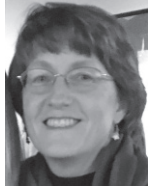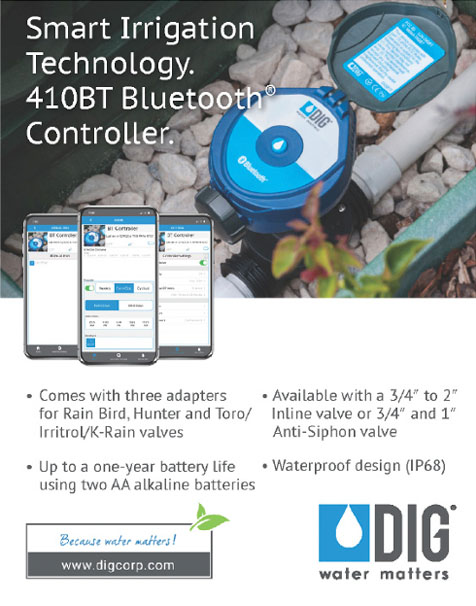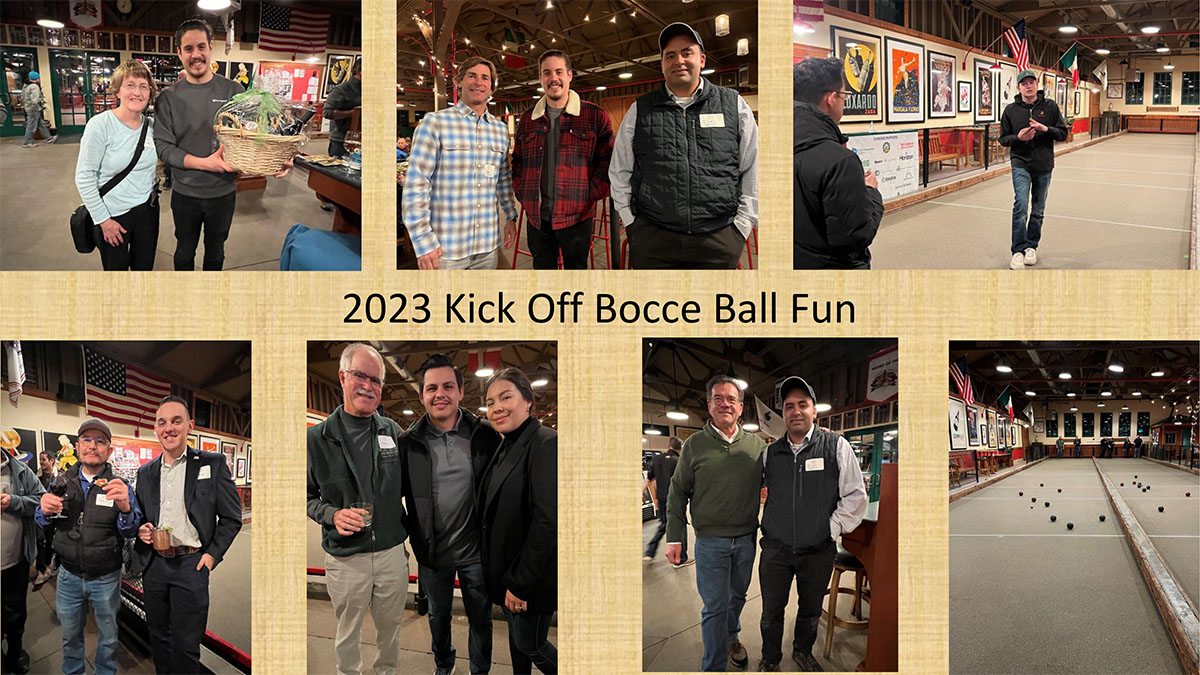In This Issue




Auxiliary Report
Has it stopped raining yet? The rain is lovely for gardens but it causes chaos for those of us working outside for a living. Clean-up will continue for a while I’m certain.
The Auxiliary had a great meeting on January 12 at the home of Mary and Barry Cohen. Thank you everyone who attended (Mary and Barry Cohen, Cindy Singletary, Vicky Parrott, Charlene Ott and Girvin and myself). We were a small but fun group. We are still early in the year but we have started planning for the Chapter Picnic and the Christmas Holiday Party. Yikes! Already? If you have any thoughts about either of these events, please email me at gpland@sbcglobal.net. Thank you everyone who has signed up for a raffle basket or committee already. I appreciate everyone’s support. Thank you, Mary for hosting the meeting. A lot of yummy food. Our next meeting is tentatively scheduled for Thursday, May 18, location still to be determined.
The January meeting at Campo Di Bocce in Los Gatos was a fun and social event. Thank you to Andrew Tuckman and Juan Carlos Esparza for organizing the evening. We were a small but energetic group with some new faces in the crowd. Welcome to Gerardo Orozco of Buckeye Landscape as a new member and January was his first meeting. Gerardo’s father Martin worked for Girvin Peters Landscape for over 20 years. Wonderful to see them with their own business and now a member of CLCA.
We were a small group but the Auxiliary raised $200 for LEAF. I guess I’m a better sales person than I thought! Thank you everyone who purchased raffle tickets. Congratulations to Erik Aichelen of Lyngso Garden Materials who won the raffle basket donated by Girvin Peters. I appreciate everyone’s support of the Auxiliary raffles and again, thank you to everyone who contributed to the raffle’s success.
It takes a lot of people to keep the Auxiliary running smoothly. I hope you will think about joining us this year and help us make the chapter events the best ever. We would love to have your creative ideas and energy in the group. Happy Valentine’s Day! I hope the day is filled with sunshine, flowers and chocolate!
Lesley Peters
Garden Designer
650-444-4580
gpland@sbcglobal.net
Article of Interest
These ‘bioswales’ were built to help prevent flooding. Here’s how they fared in Bay Area storms

When San Francisco’s new Southeast Community Center opened in October, the three acres of parkland included an expansive landscaped bioswale that, in theory, would handle the water running off from even the largest of storms.
Less than a month later, the theory was put to the test — and it passed with flying colors.
Read Full Article

Article of Interest
The Five Principles of Leadership

Definition of leadership that I believe best articulates what is required for leaders to succeed in the fast-moving 21st Century. In doing so, I foreshadowed a framework derived from more than three decades of benchmarking, learning, applying and adapting. I call it “The Five Principles Leadership” – Potential, Purpose, People, Playbook, Pay-It-Forward, and committed to devoting the next five articles to diving deep into each of these “P’s”, sharing lessons learned, best practices and pragmatic tips for implementing the model in our daily leadership habits and organizations.
With this backdrop, this is the fifth of the deeper dive articles – paying it forward.
I am fond of Mark Twain who once said that “a wise man learns from his own mistakes; a genius learns from others.” The role of a leader is to ensure those around us are “geniuses,” passing along all of the wisdom that has resulted from our mistakes and failures, so they can move forward with that accumulated knowledge and make new mistakes. I’ll focus this article on how leaders must pay it forward, leaving the team and the organization better than they found it.
There are three primary ways leaders can pay it forward in their day-to-day roles: (1) assuming the role of a leader-teacher, (2) role modeling their personal true north to set the example, and (3) ensuring the organization operates in a socially responsible manner.
The Role of a Leader-Teacher
One of the most important roles in leadership is the collection and sharing of knowledge across the organization. In today’s world, we live in a constant state of information overload, and it is the role of a leader to distill and differentiate between “noise” and “signal.” This requires a leader to develop a teachable point of view (TPOV) on major topics and trends. A TPOV is the leader’s perspective on the implications of relevant data or the company’s position on a major issue, and includes a combination of ideas, values and emotional energy.
As the adage goes, you cannot beat a story with facts … you can only beat a story with a better story. The leadership myth that you win minds in one-to-many settings, but you win hearts one-to-one is untrue. Storytelling allows you to win hearts and minds “at scale.” If you want to change a culture, you have to change the stories being told.
Three critical capabilities enable a leader to be an effective storyteller: (1) story-listening, which is the practice of creating an inventory of moments when an experience causes you to have chills (jot down those inspirational movies, songs or personal experiences for future use); (2) story-triggering, when your actions or words cause others to tell stories about you at a critical moment (i.e., the famous story of the Nordstrom employee accepting a loyal customer’s tire for a refund even though Nordstrom didn’t sell tires, simply because Nordstrom always does right by the customer – a metallic tire hangs famously from the ceiling of the Nordstrom flagship store in Manhattan to remind everyone of Nordstrom’s commitment to customers); and (3) story-telling, when you develop the skill to effectively bring the combination of these elements together to tell the right story and/at the right time. It takes practice, but storytelling is one of the most powerful tools in a leader’s toolbox and can be an effective way of distributing information and creating a culture that pays it forward.
Role Model Your Personal True North
Another favorite Mark Twain quote is “the two most important days in your life are the day you are born, and the day you find out why.” For most, we seldom take the time to reflect on whether our actions are adding up to the impact we hope to have in life. Thankfully, there is a process for “discovering your why” which I described in this article. The desired output of this process is your personal True North, or mission statement. It is both therapeutic and focusing. It is also critical to complete as a leader. We have all come to understand that tone is set at the top. Once you have developed a clear articulation of your “why,” work hard to be that person and align your decisions and actions in support of the change you seek in the world.
Social Responsibility
The Business Roundtable recently created news by publishing a perspective that alters the decades-long belief that a CEO’s role is to simply maximize shareholder value. The thought leaders from today’s most innovative and successful companies challenged this perspective as being insufficient and outdated, and published an alternative doctrine that suggests that while a “CEO’s work is to generate profits and return value to shareholders, the best-run companies do more. They put the customer first and invest in their employees and communities. In the end, it’s the most promising way to build long-term value.”
Today’s generation of socially and globally informed stakeholders have grown to expect companies to clearly articulate the social good they seek to provide in society. Institutional investors have followed suit, requiring companies to publish their Environmental, Social and Governance (ESG) scorecards, while directing their choices in which companies they will invest based upon the companies’ track record in these critical areas. What was once viewed as “doing good” has now been proven and mandated as “doing good is good business.” The odds are now stacked against your company if you fail to operate in a socially responsible manner.
The best practices of companies that do this well make social responsibility a core value in the company. They set the expectations that the company and its employees will be stewards of the future and will do their part to make the world a better place. They see it as a privilege to help others and they do it wholeheartedly. Many now back this commitment by providing every employee with a certain number of hours/year paid to volunteer to any philanthropy of their choice, and often match their monetary donations. These are becoming the new “benefits packages” that prospective employees are seeking, and social responsibility is increasingly becoming the differentiator for which company a prospective employee will choose to join in the competitive talent war. The message to all leaders and companies is simple, operate in a socially responsible manner or perish.
Paying it forward is a critical principle of today’s leadership. It is often said that how the team or company performs two years after your departure is the most telling indicator of your effectiveness as a leader. The responsibility falls to each of us to leave things better than we found them, and to ensure those who follow us are even better prepared.
What leadership practices have you found to be most effective in paying it forward?
Published By
Brad D. Smith
LinkedIn
Partner Spotlight
This month’s Partners Spotlight is Jeremy Yearton from Hunter Industries/FX Luminaire

Jeremy has been with Hunter Industries for five years. While being heavily involved on the Irrigation side with Hunter, Jeremy has taken an active role in supporting the distributors and contractors in his territory with FX Luminaire Products as well. He and Jeff Calhoun also with Hunter/FX can both be seen around the Bay Area assisting customers and being involved with the CLCA chapters.
With 20 years of experience in manufacturing, marketing and sales, Jeremy brings a high focus to customer support. He covers the Southern Peninsula, East Bay and South Bay territory of California. Jeremy says “I feel blessed to be part of this industry. To be honest I did not know it existed until a good friend pulled me in. I have spent half of my life building motorcycles and helping others to do so, but now I come home and feel like I have made a difference in my state. Helping California conserve water is why I get up and do what I do every day. Seeing a homeowner enjoy their lights for the first time is what makes this job special.”
Jeremy’s home is ideally situated in the South Bay where he and his wife Lori have three kids and have called Hollister, California home for many years. When Jeremy is not working, he spends his free time, like most supporting fathers, shuttling the kids from football, Cheer and gymnastics.
Embracing the forward strides of the industry and his current role, Jeremy is enthusiastic about implementing strategies that will help contractors reach their goals. Jeremy is passionate about sharing Hunter’s Hydrawise™ technology, a Wi-Fi based irrigation management software solution for contractors. This technology greatly improves water savings, promotes healthy landscape management, and provides contractors opportunities for decreasing labor costs and growing their businesses.
“This is a great opportunity for contractors to expand their businesses with a platform that allows them to manage many customers across a large area from one single device. This equates to huge cost and time savings,” says Jeremy.
Headquartered in San Marcos, California, since 1981, Hunter is the world leader in the development of water-efficient irrigation systems. Innovation is the cornerstone of its business. Check out some of the newest innovations: https://www.hunterindustries.com/
- The mobile-friendly Centralus™ irrigation management platform — currently available in beta phase — offers highly secure, comprehensive cloud-based control and monitoring features for ICC2 and ACC2 controllers.
- The new battery-operated NODE-BT controller is enabled with powerful wireless Bluetooth® technology that can be easily managed from a smartphone. It is the perfect choice for gardens, parks, medians, or other outdoor applications where AC power is unavailable.
- The revolutionary EZ Decoder System is designed for simple and low-cost installation so irrigation professionals can bring the power of two-wire technology to more projects than ever before. EZDS is compatible with ICC2 PRO-C and HCC controllers. Also take a look at the just released EZ-DT Wireless Diagnostic tool.
- The simple, low-cost A2C-LTE modules enables Centralus web-based management via cellular service for ACC2 commercial controllers.
Jeremy Yearton
Cell (669)253-3755
jeremy.yearton@hunterindustries.com

























